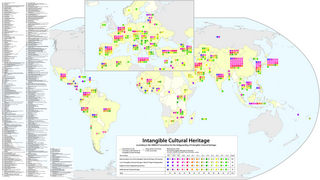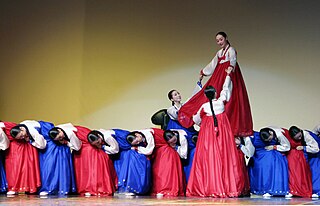| Charitable society overview | |
|---|---|
| Formed | 17 May 2010 |
| Headquarters | Riyadh, Saudi Arabia |
| Charitable society executive |
|
| Website | http://shps.org.sa/Pages/default.aspx |
The Saudi Heritage Preservation Society (SHPS) is a Saudi charitable society established on 17 May 2010 and concerned with the preservation of national heritage where the constituent meeting was held in the National Museum of Saudi Arabia. [1] It has been registered by UNESCO as an international nongovernmental organization in safeguarding heritage. [2]
On 12 July 2019, UNESCO signed a letter with the Saudi Minister of Culture of In which Saudi Arabia contribute US$25 million to UNESCO for the preservation of heritage. [3]
In 2013, the society launched several projects emphasizing on protecting and documenting archaeological sites and old buildings. [4] Moreover, the projects involve initiatives towards sculptures and skills associated with traditional arts and crafts through launching awareness campaigns and seasonal competitions. [4]
There are six elements inscribed on UNESCO's Intangible Cultural Heritage of Humanity list and five properties inscribed in the World Heritage List. [5] [6]
Elements inscribed on the Representative List of the Intangible Cultural Heritage of Humanity:
Properties inscribed on the UNESCO World Heritage Site:

Hegra, also known as Mada’in Salih, is an archaeological site located in the area of Al-'Ula within Medina Province in the Hejaz region, Saudi Arabia. A majority of the remains date from the Nabataean Kingdom. The site constituted the kingdom's southernmost and second largest city after Petra, its capital city. Traces of Lihyanite and Roman occupation before and after the Nabatean rule, respectively, can also be found.

Ardah is a type of folkloric group dance in the Arabian Peninsula, in most countries located in the Gulf Cooperation Council. The dance is performed with two rows of men opposite of one another, each of whom may or may not be wielding a sword or cane, and is accompanied by drums and spoken poetry.

Saudi Arabia is the second biggest tourist destination in the Middle East with over 16 million visiting in 2017. Although most tourism in Saudi Arabia still largely involves religious pilgrimages, there is growth in the leisure tourism sector. As the tourism sector has been largely boosted lately, the sector is expected to a significant industry for Saudi Arabia, reducing its dependence on oil revenues. This is proved as tourism sector is expected to generate $25 billion in 2019. Potential tourist areas include the Hijaz and Sarawat Mountains, Red Sea diving and a number of ancient ruins.

UNESCO established its Lists of Intangible Cultural Heritage with the aim of ensuring better protection of important intangible cultural heritages worldwide and the awareness of their significance. This list is published by the Intergovernmental Committee for the Safeguarding of Intangible Cultural Heritage, the members of which are elected by State Parties meeting in a General Assembly. Through a compendium of the different oral and intangible treasures of humankind worldwide, the programme aims to draw attention to the importance of safeguarding intangible heritage, which UNESCO has identified as an essential component and as a repository of cultural diversity and of creative expression.
Saudi Arabian art is contextual to the country being the birthplace of Islam; it includes both the arts of Bedouin nomads and those of the sedentary peoples of regions such as the Hejaz, Tihamah, Asir and Najd.

Al-Qatt Al-Asiri, is a style of Arabic art, typically painted by women in the entrance to a home. It originated in the 'Asir Region of Saudi Arabia where the front parlour of traditional Arab homes typically contained wall paintings in the form of a mural or fresco with geometric designs in bright colors. Called nagash in Arabic, the wall paintings are often considered a mark of pride. In 2017 Al-Qatt Al-Asiri was inscribed on UNESCO's list of Intangible Cultural Heritage of Humanity.

The heritage preservation system of South Korea is a multi-level program aiming to preserve and cultivate Korean cultural heritage. The program is administered by the Cultural Heritage Administration (CHA), and the legal framework is provided by the Cultural Heritage Protection Act of 1962, last updated in 2012. The program started in 1962 and has gradually been extended and upgraded since then.
Mounir Bouchenaki is an Algerian archaeologist and incumbent Director of the Arab Regional Centre for World Heritage. He was Director-General of ICCROM from 2006 to 2011, UNESCO's Assistant Director General for Culture (2000-2006), Director of the World Heritage Centre (1998-2000), Director of UNESCO's Cultural Heritage Division (1990-2000). In January 2011, he was named honorary special adviser of UNESCO Director-General Irina Bokova and of ICCROM Director-General.
Al Sadu, or simply Sadu, describes an embroidery form in geometrical shapes hand-woven by Bedouin people. Sadu House in Kuwait was established by the Al Sadu Society in 1980 to protect the interests of the Bedouins and Sadu weaving.

Qaryat Al Faw was the capital of the first Kindah kingdom. It is located about 100 km south of Wadi ad-Dawasir, and about 700 km southwest of Riyadh, the capital city of Saudi Arabia. The Al Faw archeological site reveals various features such as residential houses, markets, roads, cemeteries, temples, and water wells.
The Royal Commission for AlUla is a Saudi commission established in July 2017 to preserve and develop the 2,000-year-old archaeological and historical site of Al-Ula north-western Saudi Arabia.

At-Turaif is a historic district located in Ad-Dir'iyah, north-west of Riyadh. It is regarded as one of the more important political and historical sites in Saudi Arabia, as it represented the capital of Saudi dynasty. It was the original home of the Saudi royal family and was the country's first capital from 1727 until Ottoman control of the area in 1818.

Mezmar or mizmar is a traditional group performance and stick song-dance that is performed by in the Hejaz region in western Saudi Arabia for festive occasions such as wedding and national events. Almezmar is performed by about 15–100 practitioners in festive occasions such as wedding and national events, they twirl long sticks, beat drums and clap to songs that can pertain to a variety of topics such as heroism, praise, chivalry, love and generosity. In the past, the ritual was associated with battle or competition. It closely resembles the tahtib dance practiced in Egypt and Sudan.
Khawlani Coffee Beans are a type of coffee bean cultivated in the region of the Khawlan mountains. These mountains spread from the southwestern part of Saudi Arabia to the northwestern part of Yemen. The province of Jazan in Saudi Arabia, and the governorate of Saada in Yemen are where these mountains are situated. Those are main regions for the cultivation of this type of coffee due to the presence of all the geographical and climatic conditions required for its cultivation. The mountainous soil is rich in the necessary nutrients to give the coffee its distinctive flavour. The Khawlani coffee is characterised by an oily layer as well as its well-known and distinctive odour.